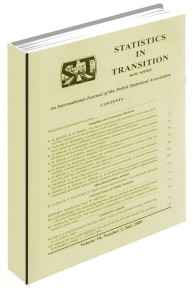Multinomial Logistic Regression Approach for the Evaluation of Binary Diagnostic Test in Medical Research
Multinomial Logistic Regression Approach for the Evaluation of Binary Diagnostic Test in Medical Research
Author(s): Alok Kumar Dwivedi, Indika Mallawaarachchi, Juan B. Figueroa-Casas, Angel M. Morales, Patrick TarwaterSubject(s): Economy
Published by: Główny Urząd Statystyczny
Keywords: multinomial logistic regression;predictive values;sensitivity;specificity;acute appendicitis;pulmonary abnormalities;medical diagnostic test
Summary/Abstract: Evaluating the effect of variables on diagnostic measures (sensitivity, specificity, positive, and negative predictive values) is often of interest to clinical researchers. Logistic regression (LR) models can be used to predict diagnostic measures of a screening test. A marginal model framework using generalized estimating equation (GEE) with logit/log link can be used to compare the diagnostic measures between two or more screening tests. These individual modeling approaches to each diagnostic measure ignore the dependency among these measures that might affect the association of covariates with each diagnostic measure. The diagnostic measures are computed using joint distribution of screening test result and reference test result which generates a multinomial response data. Thus, multinomial logistic regression (MLR) is a more appropriate approach to modeling these diagnostic measures. In this study, the validity of LR and GEE approaches as compared to MLR model was assessed for modeling diagnostic measures. All methods provided unbiased estimates of diagnostic measures in the absence of any covariate. LR and GEE methods produced more biased estimates as compared to MLR approach especially for small sample size studies. No bias was obtained in predicting sensitivity measure using MLR method for one screening test. Our proposed MLR method is robust for modelingdiagnostic measures of a screening test as opposed to LR method. MLR method and GEE method produced similar estimates of diagnostic measures for comparing two screening tests in large sample size studies. The proposed MLR model for diagnostic measures is simple, and available in common statistical software. Our study demonstrates that MLR method should be preferred as an alternative for modeling diagnostic measures.
Journal: Statistics in Transition. New Series
- Issue Year: 16/2015
- Issue No: 2
- Page Range: 203-222
- Page Count: 20
- Language: English

